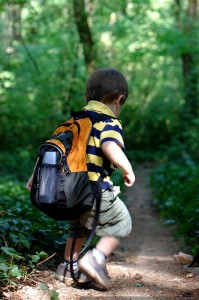 I wrote a post in September of 2010 – “Backpack Safety – Back To School and 14 Helpful Tips.” Millions of kids wear heavy backpacks that affect their posture, which results in interfering with a proper functioning of nervous system and thus leads to sick days and unnecessary pain. A post about “Relationship of Nervous System and Spine to Organs”, will provide you a better understanding of what I am talking about. A developing young organism must be free of any obstacles for proper development. It is even more true for young girls. These individuals are the future of this society. With advancing technology our future generation can save their posture by carrying all of their heavy load of books on an electronic book reader. I am talking about iPad, Kindle, Nook and probably some other electronic gadgets that are available on the market today.
I wrote a post in September of 2010 – “Backpack Safety – Back To School and 14 Helpful Tips.” Millions of kids wear heavy backpacks that affect their posture, which results in interfering with a proper functioning of nervous system and thus leads to sick days and unnecessary pain. A post about “Relationship of Nervous System and Spine to Organs”, will provide you a better understanding of what I am talking about. A developing young organism must be free of any obstacles for proper development. It is even more true for young girls. These individuals are the future of this society. With advancing technology our future generation can save their posture by carrying all of their heavy load of books on an electronic book reader. I am talking about iPad, Kindle, Nook and probably some other electronic gadgets that are available on the market today.
These devices are not as expensive as they used to be. It is a very minor investment in the future of your kids. My boy is turning four next month and pretty soon he is going to go to school. Currently he is practicing on my iPhone to play with different apps. Some of my patients are principles at schools and I have talked to them about this issue. With budget cuts in every State in the United States and over 26 billion dollars deficit for 2011 in a State of California alone it is not an easy task to accomplish. Education budget cuts are growing every year and with bureaucratic system that the State make the transfer to electronic book reader is a distant possibility.
What is the solution to this problem? I think parents must take action in their own hands and provide their kids with these light readers that weight less than a pound versus full back pack of books which can weight up to 15 pounds and sometimes even more. The solution is easy the implementation is not. Below are comparison videos of the Nook from Barnes & Nobles and Kindle from Amazon that your child can use in school.
Getting the books you buy onto as many readers as possible is a matter of great interest to educators. Right now, there are basically three ways to leverage e-books to increase distribution of titles in schools.
When Amazon came out with the Kindle, the company realized that book-buyers would want to be able to load their purchases onto more than one reading device. So the company made it possible for customers to load their purchases onto as many as six devices, in most case, if the devices were registered to the same account. As schools began to implement ereader programs, educators saw the benefit of this policy: if a school purchases six or more Kindle, every book they buy can be distributed to six devices, effectively cutting the cost of an already lower-priced e-book by a factor of six. It is like buying six copies for the price of one. And with a little extra management, this “sharing” of books among devices registered to the same account has worked well. Here is how it works for two major booksellers:
Amazon Kindle: You can download up to six copies of each book to different platforms.
Nook/Nook Color: You can download each book within devices on an account, limit six.
I think parents should take advantage of this program and send their kids to school with Kindle or Nook, pen and notepad. Make a change now before it is too late. Currently there several models available on the market: Kindle 3, Kindle DX, Nook Black & White, and Nook Color.